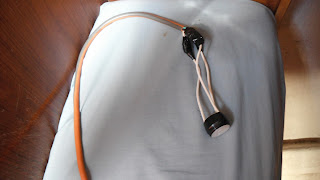 |
| Folks, Do not try this at home |
After dealing with the airline reservation problem I turned my attention to the battery bank, which was down to 12.1V. The solar panels cannot quite keep up with the electrical demands of principally the refrigerator, and yesterday's cloudy weather accelerated the drain. I was forced to run the engine for just over an hour at 1000 rpm with forward gear engaged to put a bit of a load on it. It was then that I decided to make a change that had been in the back of my mind for a while.
In MdP the 15-amp female plug that connects into the boat's electrical system had burned out and there was no chance of getting a replacement. I had 10-amp plugs but they could not accommodate the large ground pin that was required. However, I had come across the brand new core section of a 15-amp female plug. I should be able to connect this core to the shore cable and then plug it into the boat system. The risky side was that this core would not have the heavy outer covering that protects the core and is used to grip the plug.
Normally I avoid making compromises with electric wiring, but I felt compelled to have a try because if I could supply power to the boat's electrical system the big inverter would keep the batteries fully charged no matter the load. I would then not have to waste fuel and engine hours charging the batteries and I would have the convenience of being able to plug the electric jug, toaster, and computer power packs into the boat's 240V sockets.
The first problem was that the heavy wires of the shore cable were much too heavy for the plug. I found a 110V extension cord that I had purchased in the U.S. and sacrificed it to get three pieces of wire that I connected to the plug. I then joined the 3 plug cables to the 3 shore power cables with standard electrical joiners. I taped everything up, plugged into the boat, then went to the jetty and connected to shore power while braced for anything. Nothing obvious happened so I went into the boat and found the inverter working and tested a wall outlet and found it working.
Only the first of 5 LED's on the inverter was on, indicating that it sensed low batteries and it was working to maximum capacity. Over time I felt my jury rig connections and detected no heat indicating high resistance.
Brazil runs on 220V power, which is lower than the 240V used in Australia and I think Argentina too. My appliances can feel the difference. Water takes forever to boil, I have to toast the bread twice and it still doesn't brown, and the workshop light is so weak that I had to put it away and rely on the cabin battery lighting.
Before I started any work I checked the technical data on the Mastervolt 12/60-1 inverter. The mains voltage must be in the range 230V -10% and +15%, so it could deal with 220V. There is no inrush current and the input current is listed at 4 amps, which should present no big problem with the jury rig cable setup. However, running appliances, while not affecting the inverter and boat batteries, puts added load on the shore cabling which supplies power to both the inverter and wall plugs. This, I believe, is the reason why the first 15A plug burned to a frazzle. In the winter weather of MdP I was at times carelessly running the inverter and fan heater and electric jug and toaster at the same time. You live and learn. Here in Angra there will be no fan heater, of course, and I'll make sure that I do not run the toaster and electric kettle concurrently.
After lunch and a lie-down I decided to keep the electrical momentum going and reinstalled the thermostat in the refrigerator compartment. I set it to “medium” then turned on the breaker and the refrigerator came on. The next thing to do is to make sure that the thermostat is doing its work and switching the compressor on and off, but I have no reason to think that there will be a problem.
After that I enjoyed a cup of tea feeling pretty satisfied with the day's work. Time would tell whether the airline booking, jury rig shore power cable, and the thermostat efforts were successful


3 comments:
Poor Pachuca...hope its electrics are now fixed.
I think that with something like this, you need to do a little more than hope that the electrical relays are fixed. If they aren't, they will have some major problems. Thanks for sharing. I think I will be making some more stops by this blog. I like it.
That's pretty cool. Sounds like an exciting adventure! I love sailboats because of their triangular sails. Maybe I can become the first electrician in Salt Lake City who will work on a sailboat!
Post a Comment